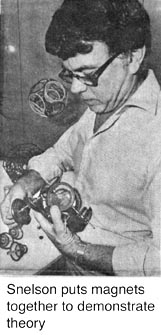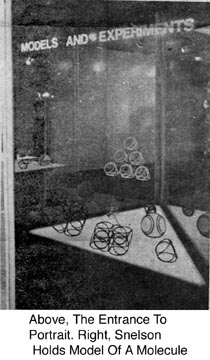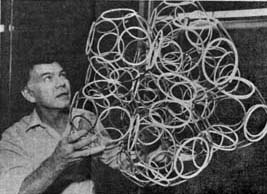
Durham Morning Herald
Friday / Leisure, Arts, And Travel
September 17, 1982


SCIENCE INSPIRES ATOMIC ART
By JIM WISE Herald Staff Writer
They're sort of eerie things, these constructions of circles and spheres. But then, they should be. They're models of things nobody ever saw or ever will see.
They're models of atoms, and they don't look anything like what you might expect.
Portrait of an Atom, an exhibition of atomic and molecular models by sculptor Kenneth Snelson, is on display at the N.C. Museum of Life and Science through October.
There are models of different kinds of atoms, displays on theories of atomic structure and photographs of models that are art works themselves.
In one, the image seems to glow with a delicate, barely discernible blue; another is a galaxy of red and white constructions jumbled against a black background.
The exhibit is an example of art passing as science or vice versa. The models are based on Snelson's own theory of how atoms should look.
 AS A CHILD, Snelson, writes in one of the commentaries with the exhibit, "Building models of things was part of my fantasy world. If I wanted a drum-set, an airplane or a racecar, I could bring it to life in replica."
AS A CHILD, Snelson, writes in one of the commentaries with the exhibit, "Building models of things was part of my fantasy world. If I wanted a drum-set, an airplane or a racecar, I could bring it to life in replica."
Similarly, atoms, "a subject which always intrigued me," he said in a lecture at the Duke engineering school last week. "If you're interested in structure, you must wonder about atoms and wonder what one would look like."
Snelson's atoms do not look anything like the little solar systems, with electrons in orbit around a proton-neutron nucleus, often used to illustrate at mic structure. Those are little more than symbols.
ACTUALLY, Snelson said, since the 1920s there has been no scientifically accepted model of how an atom looks, and it has been thought a waste of time to try to discover one.
In the 1920s, physicists discovered that electrons behave much like light waves. They also found it is impossible to actually follow an electron in its orbit, or to pinpoint where it is at any given moment. The most that can be calculated is the probability of an electron being at a particular point at a particular time, a situation Snelson compares to seeing a crowd in Grand Central Station without being able to pick out any particular person.
Scientists subsequently abandoned any effort to learn how electrons actually move, and how atoms might look, Snelson writes in his exhibition catalogue. Such pursuits are considered unscientific.
 SNELSON, though, has a theory, based on his own study of physics and chemistry, which is the basis of the models in his exhibition.
SNELSON, though, has a theory, based on his own study of physics and chemistry, which is the basis of the models in his exhibition.
"The exhibit is about an attempt I have made to define the atom as a device," he said, "an actual structure." Snelson's approach to art, he said, has been "far from the aesthetic formalism taught in art school."
He studied painting and sculpture at the University of Oregon, and spent the summers of 1948 and 1949 at Black Mountain College in North Carolina. At Black Mountain, he met designer Buckminster Fuller-originator of the geodesic dome-and became interested in "aspects of structure, form and space which were not met in art school."
SNELSON has built his reputation as a sculptor with his "tension structures," elaborate constructions of wires and tubing that often seem to defy gravity, and were not accepted by the art world as art for many years.
Through his tension sculptures, Snelson got interested in circles and began toying with a set of round magnets. The magnets' attraction and repulsion properties intrigued him. He explored the ways magnets could attach to each other, and found a striking similarity between magnetic structures and atomic ones.
That observation led to Snelson's atomic model, which depicts electron orbits as small circles on the surface of a sphere, held in place by a balance of forces between the atom's nucleus and the other electrons.
Like his sculptures, Snelson seems to thrive on tension. Just as he was at odds with "aesthetic formalism" in art, he is at odds with "orthodox" physics.
"I could be a crank, or I could be right on," he said. "I'd be treated the same either way.
"I don't think any physicist I've ever talked to has listened long enough to know what it's about," Snelson said. "We talk a different language. .
"Any physicist who came up with an idea like this would lose his place on the faculty."
In the exhibit, there is a display of letters titled "Response By the Scientific Community."
Chemist Linus Pauling wrote Snelson, "I do not think that your ideas about the electronic structure of atoms, molecules and crystals have any value."
On the other hand, Edwin R. Fitzgerald of Johns Hopkins wrote him, "I strongly endorse and favor your attempts to picture the atom in some way; modern art and literature need to come to grips with the increased knowledge provided by science and with the influence of 'technology on man."
 "I've read stacks and stacks of physics books," Snelson said. "I feel entitled, as a structuralist, to make these speculations. I'm trying to get it known that there's an alternative model.
"I've read stacks and stacks of physics books," Snelson said. "I feel entitled, as a structuralist, to make these speculations. I'm trying to get it known that there's an alternative model.
"There's room for these speculations that have entertained philosophers for centuries."


Inside / Movies 'Ridgemont High' / Stage Kid's Drama Group Formed In Durham --100 / Music Anniversary Admirable For N.C. Symphony --70




 AS A CHILD, Snelson, writes in one of the commentaries with the exhibit, "Building models of things was part of my fantasy world. If I wanted a drum-set, an airplane or a racecar, I could bring it to life in replica."
AS A CHILD, Snelson, writes in one of the commentaries with the exhibit, "Building models of things was part of my fantasy world. If I wanted a drum-set, an airplane or a racecar, I could bring it to life in replica."
 SNELSON, though, has a theory, based on his own study of physics and chemistry, which is the basis of the models in his exhibition.
SNELSON, though, has a theory, based on his own study of physics and chemistry, which is the basis of the models in his exhibition.
 "I've read stacks and stacks of physics books," Snelson said. "I feel entitled, as a structuralist, to make these speculations. I'm trying to get it known that there's an alternative model.
"I've read stacks and stacks of physics books," Snelson said. "I feel entitled, as a structuralist, to make these speculations. I'm trying to get it known that there's an alternative model.

